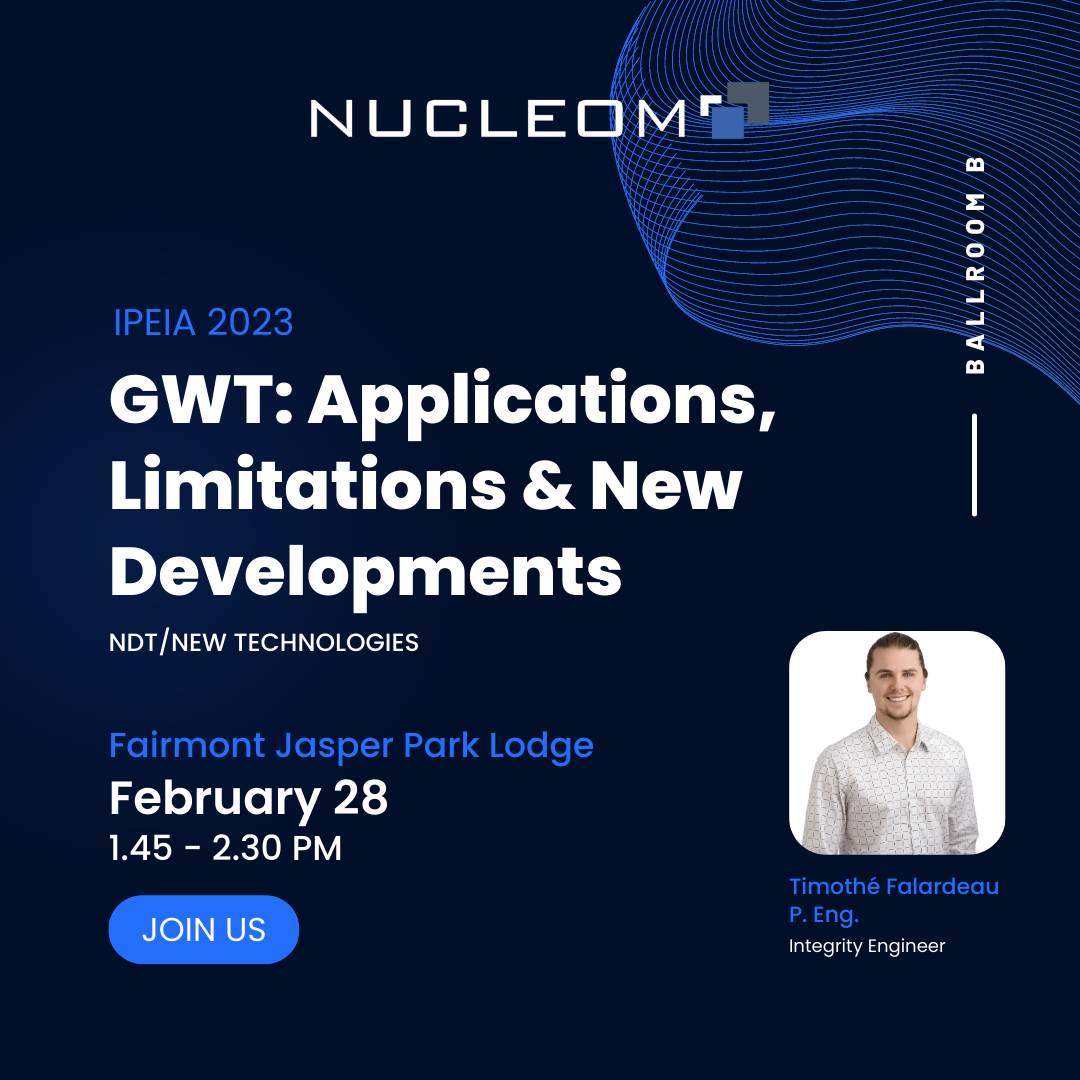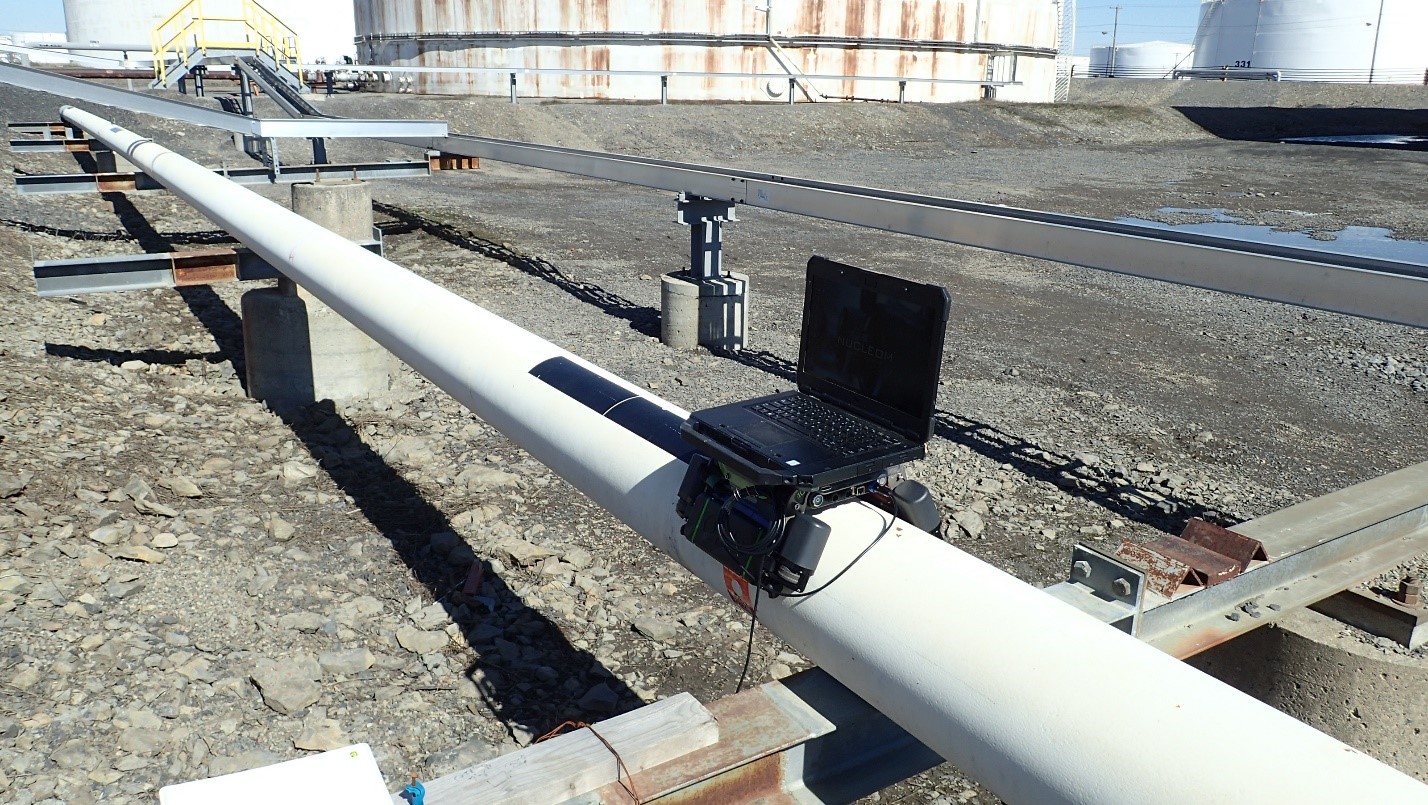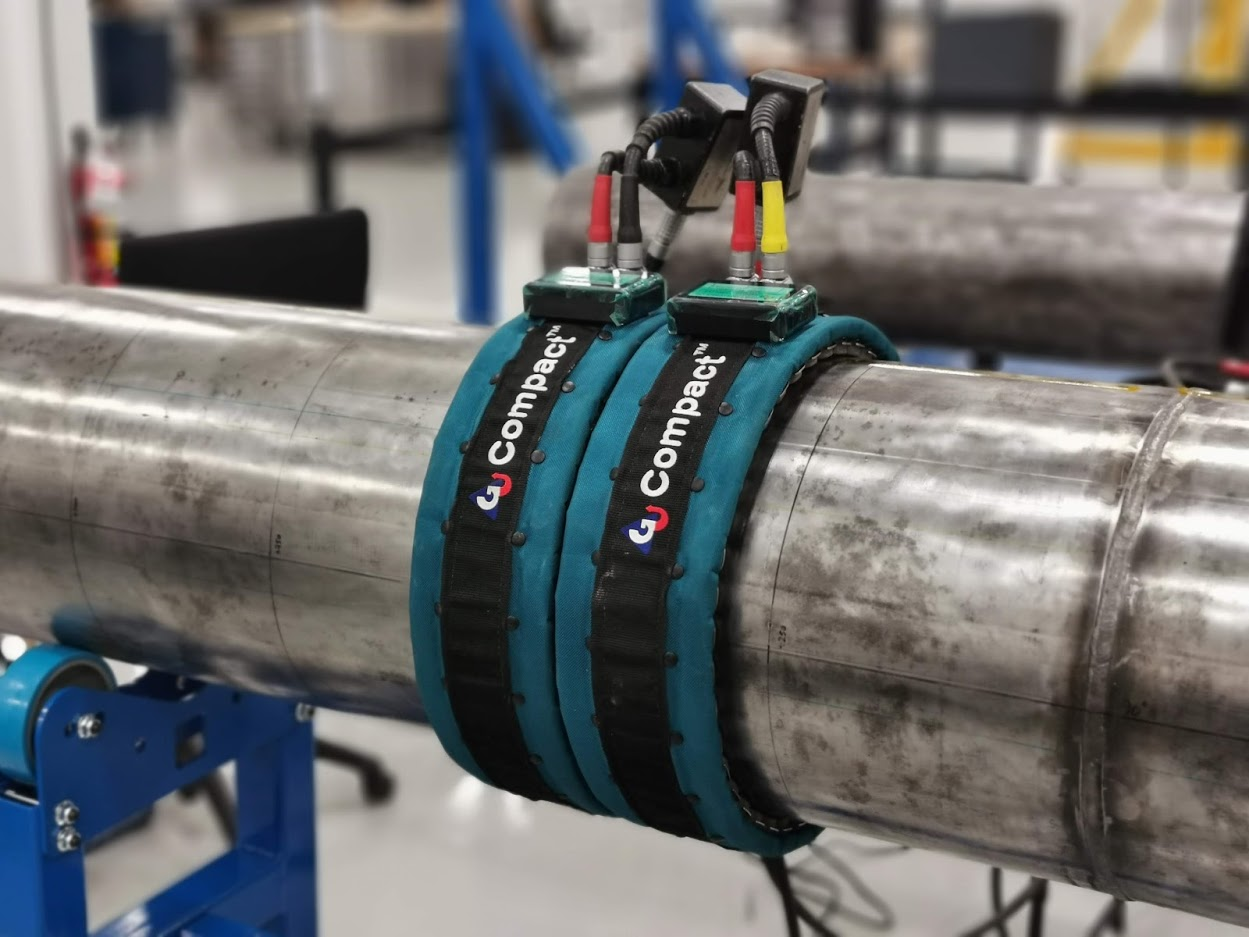Guided wave ultrasonic testing: applications, limitations, and new developments
This paper entitled “Guided Wave ultrasonic testing: applications, limitations and new developments” was presented at IPEIA 2023 in Jasper, Alberta, by Timothé Falardeau, integrity engineer at Nucleom.
Long-Range Guided Wave Testing (GWT) 
Applications- examples:
- High productivity: GWT of fire piping in a mine. 2km, 100% inspected in 3 days
- Buried piping: GWT of dike crossing in distribution terminal. 8 10 dike crossing / day
- Insulated piping: GWT of high temperature piping. Up to 350⁰C (HT collars)
- Reduced confined spaced exposure: GWT of culvert crossing. 15 culvert crossing / day
- Reduced work at height exposure: GWT of piping in pipe rack. 1 shot every 500 ft
Limitations:
- Qualitative. Defect categorized into severity: Minor 0 25% wall loss, Medium 25 – 50% wall loss, Severe 50+% wall loss
- Direct access required at test point.
- Cannot test through thick coating (ex. Bitumen wrap, yellow jacket).
- Surface prep may be required (remove anything loose).
- Can inspect most metals (steel, aluminium, copper, etc.)
- Diameter: NPS 1.5 NPS 60+
- Radial clearance: 1.5″. Axial clearance: 6″ (12″ recommended)
- Up to 150⁰C (standard rings). Up to 350⁰C (high temp rings)
- Near field/deadzone 3 ft each side (regular collar). Down to 6″ HD collars.
- Range of inspection influenced by multiple factors
- Configuration (elbow/flange/tee)
- Pipe condition
- External environment (noise, soil, insulation)
- Material (optimized for carbon steel)
Short/ Medium range GWT
Applications:

Quantitative measurements (actual thickness measurements)
- Corrosion under pipe support (CUPS) using the QSR1
- Bottom side corrosion (pipe laying on the ground) using the QSR1
- Soil-to-air interface (SAI) testing using the Axial QSR1
- Wall penetration testing using the Axial QSR1
Limitations:
- Axial clearance: 12” (QSR1) 15.4” (Axial QSR)
- Radial Height (circumferential clearance): 3.4” (Axial QSR)
- Surface preparation: Wiped clean of loose debris. Coating thicker than 1mm must be remove under the sensor
- Applications: Non welded simple supports (QSR1)
- Wall penetrations testing / complex supports (Axial QSR)
- Pipe temperature: -20⁰C to 70⁰C
- Length of test (Axial QSR): 2” 20” axially
New development and advanced applications
Long range GWT
High-definition Compact modules

- Interface testing (ex. pipe in concrete) or corrosion at supports
- Reduced near field and deadzone
- Higher sensitivity
- Lower reflection from wall/soil penetration
- Magnetostrictive sensors
- High signal to noise ratio (SNR)
- Tight radial clearance (1”)
- High sensitivity
Permanent monitoring
- Improved accuracy
- Quantitative measurements possible
- Corrosion rate estimation
- Ideal for critical pipelines/piping
High temperature (up to 350 C)
QSR1
- GUL high power sensors increase SNR and transduction power
- GUL ML algorithm (machine learning) can quantify up to 100% wall loss
- GUL ML algorithm (machine learning) in development for corrosion at welded support
3 main points to remember:
- Fast: 15 min/test GWT; 15 min/m QSR
- 100% coverage: GWT for screening; QSR for quantitative measurements
- Trustable: Very high probability of detection (POD)
 WRITTEN BY TIMOTHÉ FALARDEAU, M. SC.
WRITTEN BY TIMOTHÉ FALARDEAU, M. SC.
Timothé is currently involved as a guided wave manager and integrity engineer at Nucleom. He has also been previously involved as a project manager, supervising major projects both on-site and off-site. He is now managing the guided wave department and has participated in numerous inspection campaigns at various utilities, performing analysis, data acquisition, site support, technical writing, as well as developing new inspection process such as long range (LRUT) and short-range guided wave (QSR) evaluation of piping. Timothé is a Professional Engineer, member of the “Ordre des ingénieurs du Québec” (OIQ) and holds a master’s degree in mechanical engineering, focusing on advanced ultrasonic application such as guided waves applications (GW), total focusing method (TFM) and full matrix capture (FMC).
About Nucleom
Nucleom is a Canadian non-destructive testing (NDT) company headquartered in Quebec City (Quebec), with offices in Montreal (Quebec), Whitby (Ontaior), Kincardine (Ontario) and Edmonton (Alberta). Providing a wide range of non-destructive testing services, Nucleom offers solutions that significantly increase the speed and reliability of inspections on critical equipment. Nucleom is pushing the boundaries of non‑destructive testing to safeguard the operation of critical infrastructures such as nuclear reactors and pipelines. The Nucleom team works in Canada and around the world, primarily on Canada’s world-renowned CANDU reactor technology, to ensure these workhorses of the nuclear power industry continue to work safely and thus integrate the principles of social and environmental responsibility.